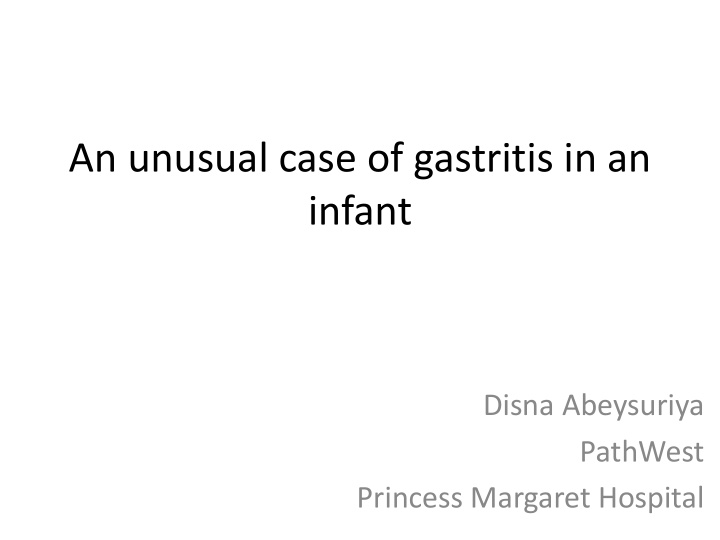



An unusual case of gastritis in an infant Disna Abeysuriya PathWest Princess Margaret Hospital
Acknowledgements • Dr Kunal Thacker – Paediatric gastroenterologist • Dr Gareth Jevon – Paediatric pathologist
Hx • Baby AF, 10 month old Australian aboriginal girl presented to ED with billious vomiting for 2 days. • No other illness.
Ex • Lethargic and dehydrated requiring fluid resuscitation • Blood stained nasogastric aspirates
Ix • Mildly low Hb 141 g/l • X ray abdomen – grossly distended stomach with intramural gas and pneumatoperitoneum. Suggestive of emphysematous gastritis
Mx • Laparotomy – confirmed pneumatosis of the stomach wall and lesser omentum. • There was no peritoneal free air or contamination. • Intraoperative gastroscopy – severe diffuse gastritis with sloughing of mucosa and ulceration. • Duodenum was distended and could not be traversed beyond the level of ampulla of Vater. • Duodenal web found at D4 and was resected.
Histology • Duodenal web • Biopsies from Oesophagus, gastric antrum and duodenum • DDx - micrococcus
Sarcina organisms • First documented in 1842 in the stomach contents of a patient with pain, bloating and vomiting • Sarcina ventriculi • Nearly spherical cells 1.8-3 micrometres • Distinct packeted morphology - tetrad or octad (8-10 micrometres) • Gram positive cocci
• Non motile, acid tolerant bacteria - can live in low pH environment of stomach • Organism on the luminal mucosal surface without direct invasion or reaction of the epithelium • Obligate anaerobe
• Sole energy source is fermentative metabolism of carbohydrate, produces CO 2 as a by product • Ubiquitous and found in soil and air • Found in livestock and faeces of vegetarians • Innocent bystander in healthy humans unless in the setting of gastro paresis or gastric outlet obstruction when it overgrows in stagnant food debris.
• Only 9 cases of human infection are reported in literature • Ages 12-73yrs • All cases had retained food in the stomach due to anatomic or physiologic delay in emptying the stomach • Bariatric surgery, small bowel resection, pancreaticoduodenectomy, gastric pull through for oesophageal atresia, tumour/mass, diabetic gastroparesis, obesity and metabolic syndrome • Complications – frothy vomiting, abdominal pain and distension, iron deficiency anaemia, gastric ulcer, emphysematous gastritis and gastric perforation
Management • Commensal in patients with poor gastric emptying – No drug treatment. Identify the cause • Prominent dysphagia or pain – PPI and prokinetic Rx • Sarcina seen in an ulcer or eroded stomach – Gentamycin, metronidazole or ciprofloxacin to eradicate • Confirm eradication with repeat endoscopy 3- 6 months
• Baby AF recovered well from surgery. • Emphysematous changes disappeared within a few hours. • Discharged with PPIs • Repeat endoscopy 7-8 weeks later – complete macroscopic and histological resolution. • This is the only reported documented case of Sarcina in an infant.
References • Sarcina ventricularis complicating a patient status post vertical banded gastroplasty: A case report. Journal of gastroenterology and hepatology research. 2015;4(2) • Sarcina ventriculi of stomach: A case report. World J Gastroenterol 2013;19(14):2282-2285 • Sarcina organisms in the gastrointestinal tract: A clinicopathologic and molecular study. Am J Surg Pathol 2011;35(11):1700-1705 • Physiological Adaptations of Anerobic Bacteria to low pH:Metabolic control of proton motive force in Sarcina ventriculi. Journal of bacteriology. 1987;2150-2157.
Thank you
Recommend
More recommend